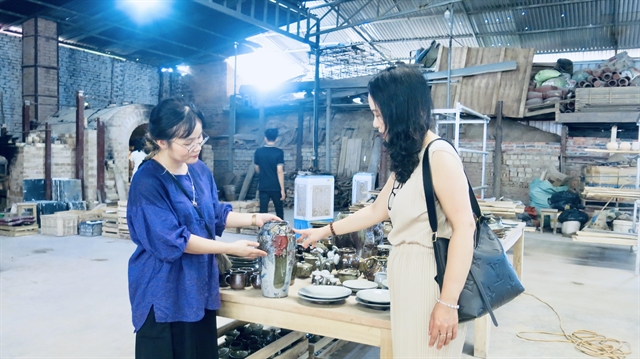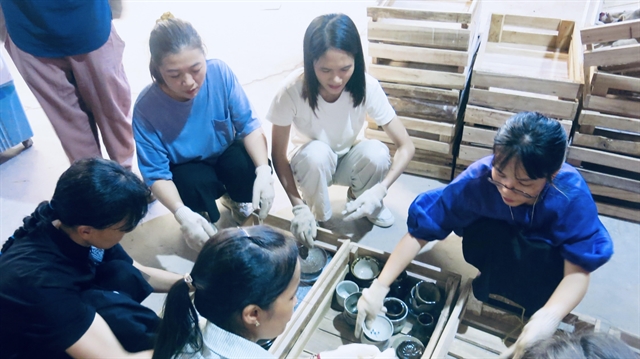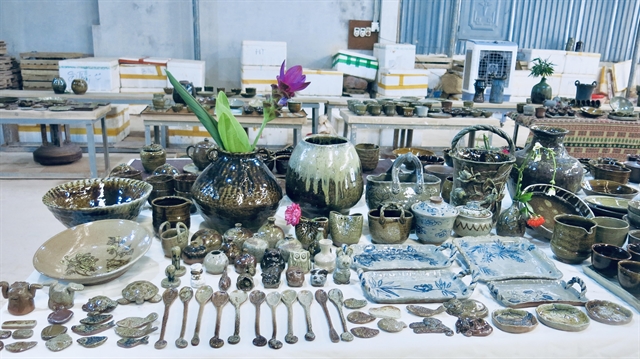 |
| Yusuke Onimaru (first, left) is giving freshly-fired pottery product to his students .—VNS Photo Nguyễn Hằng |
By Nguyễn Hằng
BẮC NINH — Yusuke Onimaru, 52, a master potter from Japan, is seen drenched in sweat, dressed in a navy t-shirt and light-grey khaki trousers with an orange towel draped over his shoulder to mop his brow.
He is busy unloading a batch of freshly-fired pottery from the kiln alongside his students at Phù Lãng pottery village in Quế Võ District, Bắc Ninh Province, on a sweltering July afternoon.
The latest batch includes a charming array of household ceramics such as mugs, plates, bowls and decorative pieces.
Onimaru is part of a collaborative initiative between Việt Nam and Japan, which has been running for the past three years to train 52 students at the village and develop the local pottery industry.
He is involved in teaching and guiding the students, with his daily routine stretching from dawn till dusk.
Typically, Onimaru and his students begin their day with a meeting to agree on the schedule and assign specific tasks to each student.
The trainees are instructed in the use of clay and various pottery techniques through three distinct courses.
Particularly on kiln firing days, Onimaru and his students may work non-stop for up to 30 hours.
“At first, my students had to struggle with exhaustion and sleep deprivation while tending the kiln overnight. However, they then adapted and worked alongside me for 30 hours continuously,” he said.
Initially, both the students and the local villagers were skeptical about whether they could produce such refined and high-quality pottery.
“To boost their morale, I introduced them to traditional Japanese ceramics and strived to guide them in creating similar high-quality pieces over the three years,” he added.
He admitted to having concerns about maintaining cleanliness in the workshop at the start, but soon realised that the students diligently cleaned their workspace every day.
“The students here show great respect for their teachers, which has made the work environment very conducive. I believe the advantages far outweigh the challenges,” he added.
A valuable opportunity
Bùi Văn Huân, 34, a graduate of the University of Industrial Fine Arts with a major in traditional ceramics, is one of the standout students.
He said “When I heard about the project in 2022, I saw it as an incredibly valuable opportunity to further my skills and experience in ceramics.”
Through the project, Huân and his fellow students have acquired basic techniques for crafting small, delicate household ceramics using traditional methods.
Prior to the course, Phù Lãng Village’s artisans specialised in producing large-scale items such as water jars, which were difficult to sell and of relatively low value. Producing the large ceramics also consumed considerable resources, including clay and firewood.
The course has helped change the local approach to pottery. The shift not only reduced environmental impact but also conserved resources while potentially increasing value, he said.
The pottery village, with a history spanning over 800 years, has long been involved in making household ceramics like bowls and dishes.
However, Huân and other classmates had yet to learn the techniques for making the smaller items.
The course provided them an opportunity to learn these techniques directly from Japanese instructors.
“Instead of spending approximately ten years rediscovering traditional techniques through antique ceramics, we received direct guidance from our teachers, allowing us to learn much more rapidly,” Huân said, adding that the course is completely free of charge.
Huân has had the opportunity to visit Japan twice, touring the Toho pottery village in Fukuoka Prefecture and exhibiting products in Tokyo.
The trips offered valuable insights into how pottery was made in Toho village, visits to pottery museums and lessons on market presentation.
“Our instructors have even created a website for us, which will enable us to sell and showcase our products in Japan once we have perfected our techniques and produced quality items for the Japanese market,” he added.
 |
| Hoàng Thị Thủy (left) presents her product to a visitor in the project’s shared production kiln in Phù Lãng Village.—VNS Photo Nguyễn Hằng |
Another student, Hoàng Thị Thủy, 34, who graduated in fashion design from Hồ Chí Minh City University of Technology, said at first, she just wanted to challenge herself when she learned about the project.
But during the course, she discovered her passion for ceramics and decided to leave fashion design behind to pursue pottery.
“Now, my new path and dream are to work in ceramics,” she said.
Despite some believing that the work was too physically demanding for women, Thủy found joy and satisfaction in her new vocation.
“Every time I create a piece and see it completed, I feel very happy,” she said.
Thủy said she has gained a deeper understanding of the traditional value of handmade ceramics and felt she received a lot from the experience.
Lessons from the master
Huân said firing ceramics using traditional wood kilns was extremely labour-intensive. Opting for wood-firing over electric or gas kilns was already a challenging choice.
The process of making ceramics was inherently messy, with hands and feet constantly caked in mud and tending a kiln through the night was genuinely arduous.
“There have been times when I was so ill and exhausted, but still had to get up to tend the kiln,” he said.
“There were nights when both the teacher and students were so tired from watching the kiln that we had to splash water on our faces continuously to stay awake, as we had to add firewood regularly throughout the firing process.”
Huân also said he learned a lot from Onimaru.
“There were days when everyone worked non-stop from morning until 11 pm or midnight, only taking a brief break for meals before resuming. The next morning, we would start again at 5 am to monitor the kiln. Despite this intense schedule, Onimaru remained highly dedicated.”
Once, Huân asked Onimaru that why, despite his success and comfort, he stillchose such a demanding job. Onimaru replied to Huân “This is my life’s goal. I found my purpose in life through working with ceramics.”
The statement has been a tremendous source of motivation for Huân as he pursues his own career in traditional ceramics.
Huân, who was born in a pottery village, has always loved ceramics and aspired to establish his own brand.
His early experiences included scavenging for shellfish, where he often came across fragments of pottery, which he sees as a fortuitous introduction to the craft.
After graduated from the University of Industrial Fine Arts in 2014 and worked for various pottery workshops across the country for many years.
In 2020, he returned to his hometown and opened his own workshop to pursue his passion for ceramics and was later introduced to the project.
“The project has been a vital boost, allowing me to live out my passion,” he said.
Success and future plans
 |
| Students with a new batch of freshly-fired pottery in the project’s shared production kiln in Phù Lãng Village.—VNS Photo Nguyễn Hằng |
Nguyễn Bá Huân, vice chairman of the People’s Committee of Phù Lãng Town, said the project has trained 52 students across three courses and selected 14 outstanding students for a special advanced training programme in Japan.
The project, executed by Onimaru Setsuzan Kamamoto Co., Ltd. and Toho Village, along with Phù Lãng Commune People’s Committee and Quế Võ District People’s Committee, was part of Japan International Cooperation Agency (JICA)’s Development Partnership Programme.
Approved by the provincial People’s Committee on July 28, 2021, the project has four main objectives.
The aims consisted of guiding pottery techniques using Japanese methods to produce high-quality and aesthetically pleasing ceramics; preserving and developing the pottery craft for future generations and boost local economic development; promoting Phù Lãng’s pottery globally and devising a future development plan, especially for collaboration with Japan; and enhancing cultural and economic exchanges between Bắc Ninh Province and Fukuoka Prefecture, strengthening the strategic partnership between Việt Nam and Japan.
The project has held two exhibitions, one in Tokyo in April 2024 and another at the Việt Nam Women’s Museum in Hà Nội in June 2024.
The exhibitions attracted numerous international visitors, aiding in the promotion and sale of the project’s products.
Through the courses, teachers from Japan highly praised the students’ technical skills in shaping products, he said.
“Gratitude is extended to JICA and especially to Onimaru and his team for their dedication and responsibility in teaching the students and introducing Phù Lãng’s ceramics to the world,” he added.
As the project concluded in this August, there was a request for Onimaru’s company to allow the 14 students to form a cooperative to continue developing the pottery village.
Additionally, the provincial People’s Committee was investing VNĐ19 billion (US$750,700), focusing on developing the craft village and tourism in the future.
However, challenges still remained, including the traditional nature of Phù Lãng ceramics, which limited product variety and marketability.
Additionally, pottery production was fragmented, requiring a comprehensive plan for village development and tourism.
Nguyễn Huy Thành, deputy chairman of Phù Lãng Commune, asked JICA to assign a volunteer to continue supporting the village in developing traditional ceramics.
Tsuchimoto Amane, from the JICA Việt Nam Office said the project arose from the need to address the decline of traditional craft villages due to rapid modernisation and industrial growth.
The initiative aims to enhance the skills of Phù Lãng artisans, integrating traditional and modern Japanese techniques to improve income and resource efficiency, contributing to the local pottery industry’s development.
The project established a shared production facility with a traditional Japanese kiln model, trained 14 young outstanding artisans in traditional and modern techniques and built a network of passionate individuals committed to traditional pottery.
The world’s ceramics hub
 |
| Pottery displayed iatthe project’s workshop in Phù Lãng Village.—VNS Photo Nguyễn Hằng |
Onimaru said after touring all the pottery villages in Việt Nam, he ultimately chose Phù Lãng village to implement the project because the residents still produced ceramics entirely by hand in the village.
The pottery was made using traditional techniques and the materials were all natural, allowing for the creation of high-quality ceramics with global appeal.
“The village uses many traditional pottery techniques, which aligns perfectly with our criteria. When all elements are natural and handcrafted, tourists will find it very intriguing,” he said.
Onimaru’s ultimate goal was to preserve traditional ceramic craftsmanship.
With modern technology increasingly dominating pottery production, there was a risk that handcrafted items imbued with the artisan’s spirit might fade away.
“I feel it is essential to protect these ‘handcrafted’ cultural elements. That’s why I decided to carry out the project in Phù Lãng village,” he explained.
Globally, including in Japan and other advanced countries, machinery was widely used in ceramic production. Yet, when Onimaru introduced the entirely handcrafted ceramics from Phù Lãng village to his international friends, they were very impressed.
“I hope people will recognise that Việt Nam has the potential to become a new global hub for this craft. I want many people around the world to visit and experience the beauty of the craft village,” he added.
Onimaru, who along with his father has a long lineage in ceramics, inherited the craft’s rich traditions from his ancestors and he is keen to pass on his knowledge and experience to future generations.
“I am very eager to establish the place not only as a centre for ceramics in Việt Nam but also on a global scale,” he said.
Onimaru, graduated from Osaka University of Arts, Plastic Art Course, Crafts Department in 1995. In 1998, he started pottery making in Koishiwara, Fukuoka Prefecture.
In 2012, he had an exhibition at the Biennale of Contemporary Pottery and Ceramics of Sevres, held by the National Museum of Ceramic of Sevres in France. In 2015, he had an exhibition at the Revelations art event held at the Grand Palais in Paris, France. In 2016, his cups were exhibited at the Japanese Emperor’s birthday celebration reception at the Consulate General of Japan in San Francisco.— VNS
- Reduce Hair Loss with PURA D’OR Gold Label Shampoo
- Castor Oil Has Made a “Huge” Difference With Hair and Brow Growth
- Excessive hair loss in men: Signs of illness that cannot be subjective
- Dịch Vụ SEO Website ở Los Angeles, CA: đưa trang web doanh nghiệp bạn lên top Google
- Nails Salon Sierra Madre
 VnExpress News The News Gateway of Vietnam
VnExpress News The News Gateway of Vietnam





